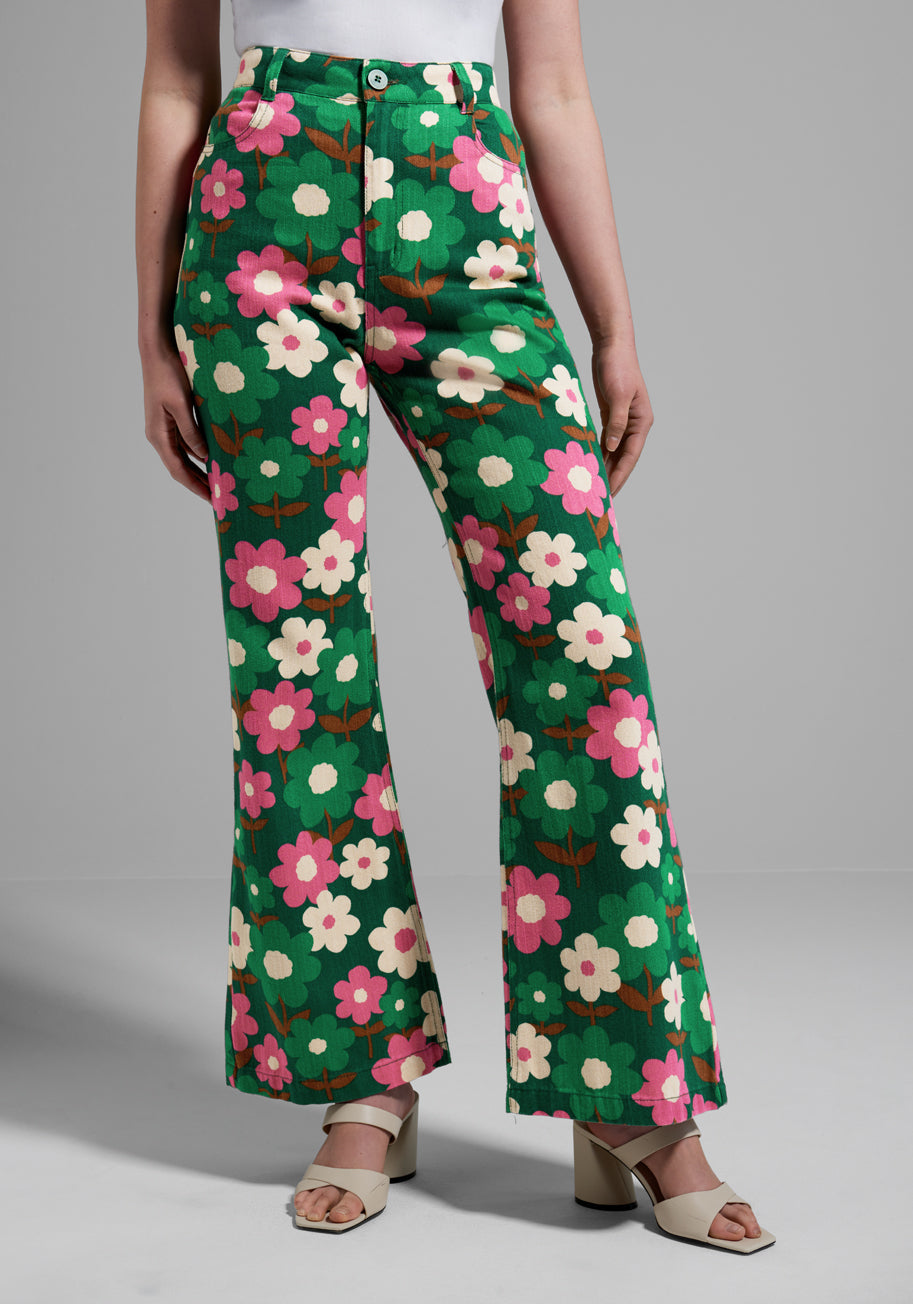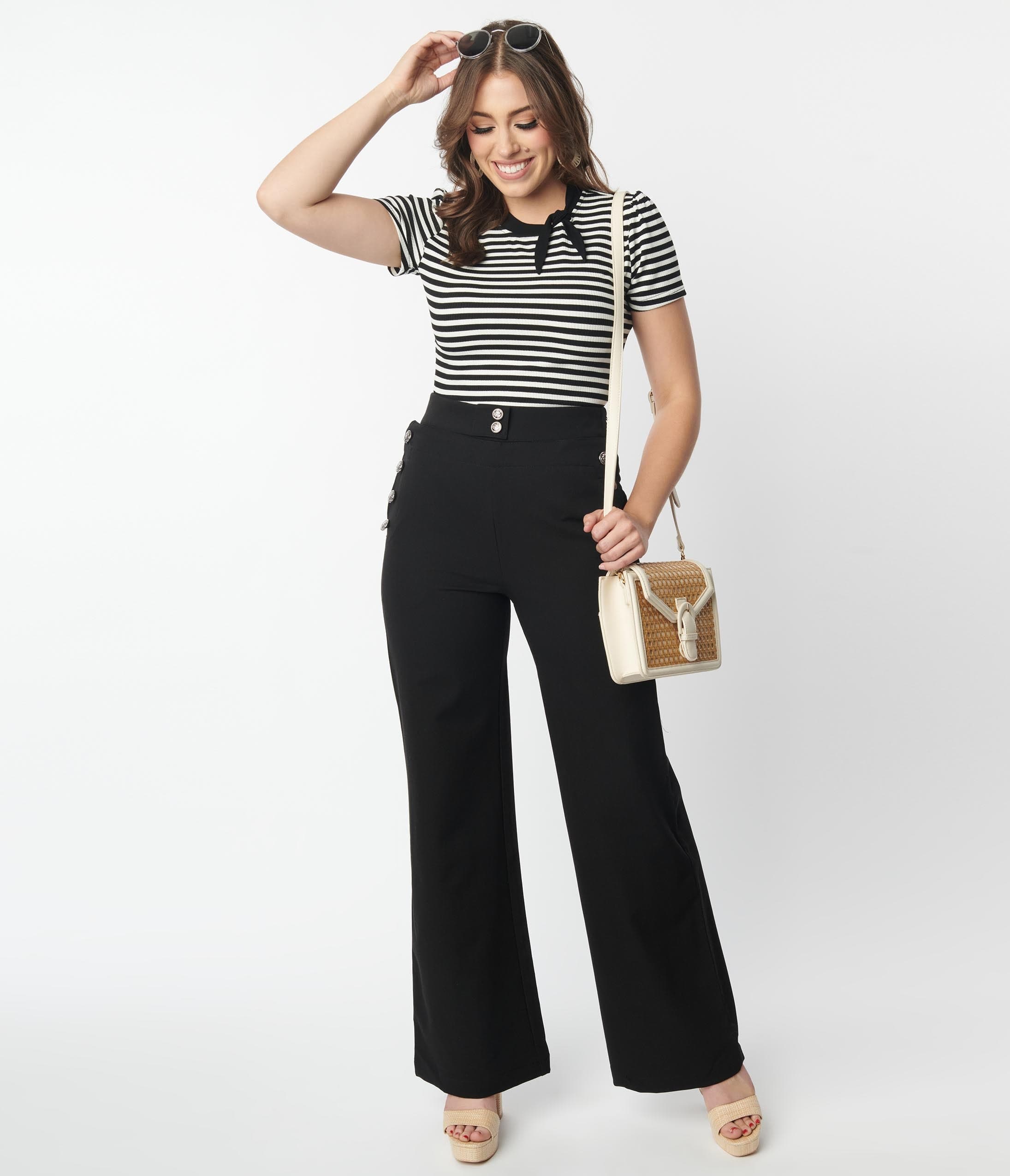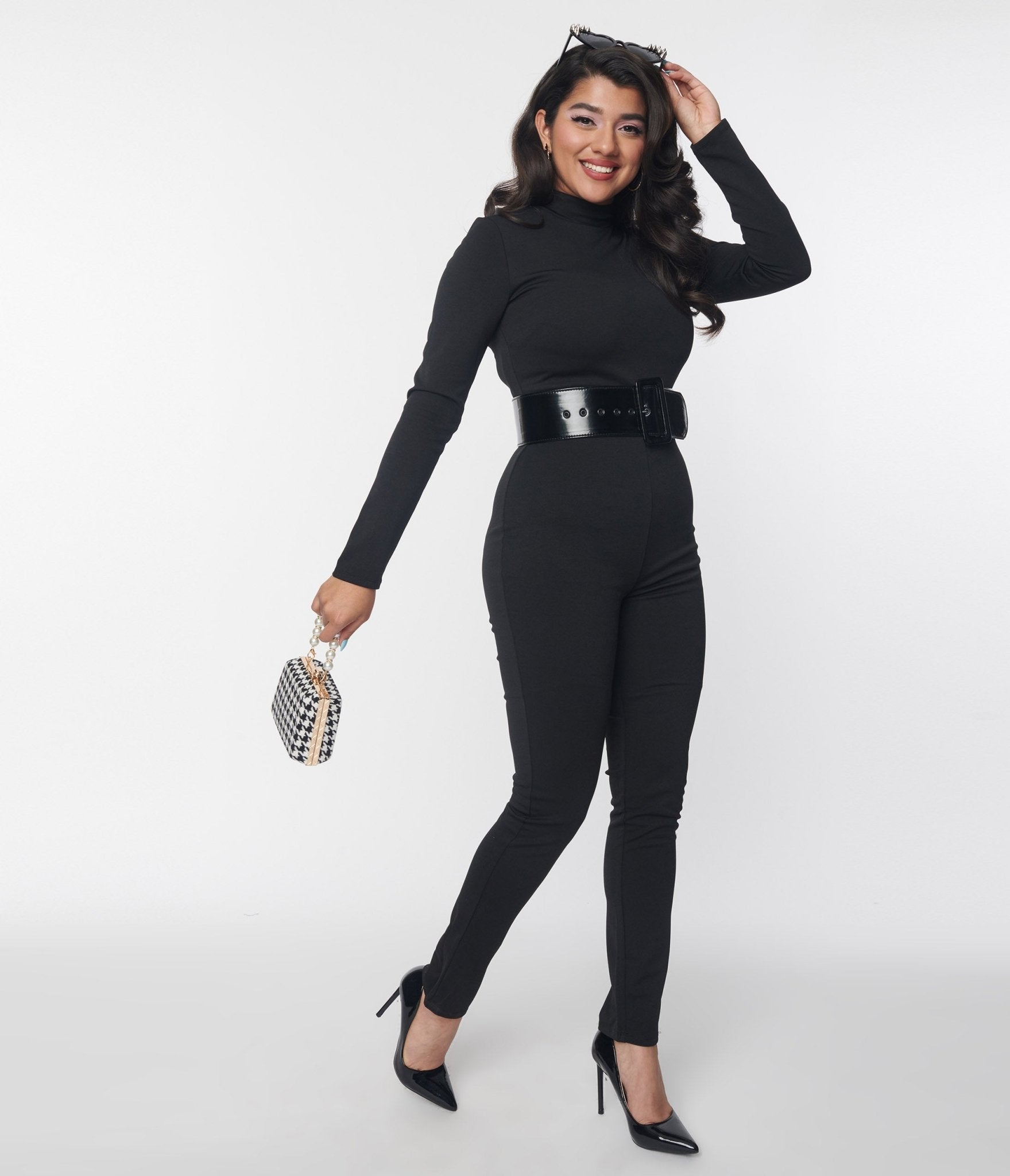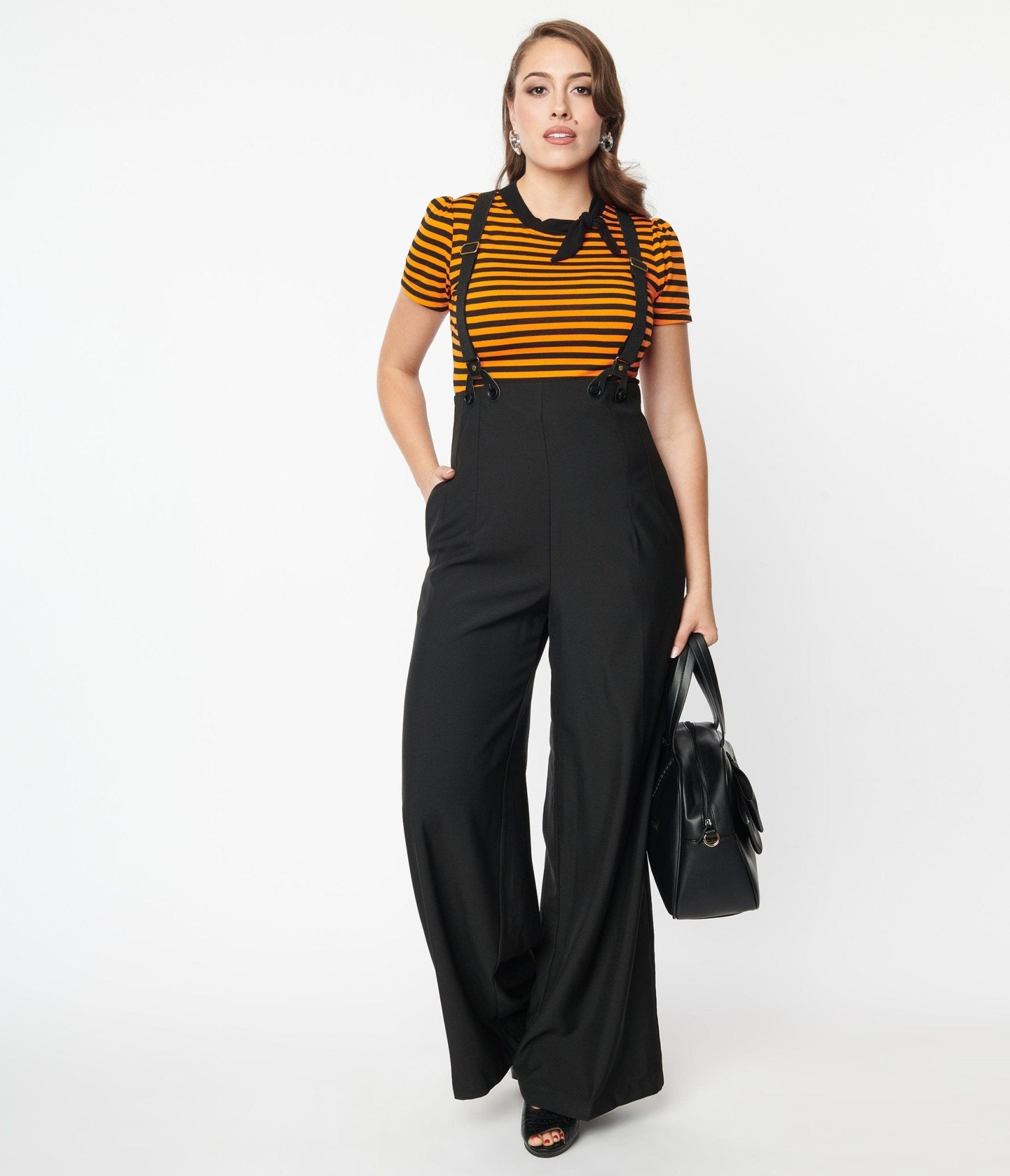The 1960s were a fascinating time for women’s pants, trousers, slacks, and jeans. The ’50s aesthetic body hugging style of the early 1960s was a stark contrast to the end of the decade when the bell bottom hippie look took over. In between was the mod era of bright colors, funky patterns, cropped ankles, and a slim fit — much like the latest round of “skinny fit” modern pants.

1967 Hip Huggers and Classic Jeans
Besides the ’60s pants styles, there was an evolution of social acceptance for women to wear pants. Not just for casual outfits at home anymore, women were making pants acceptable in the workplace and as evening wear, too. It was an uphill battle that experienced great strides in the 1960s.
Skip the history and shop 1960s style pants.
1960s Tapered Pants
The 1950s cigarette pant was renamed the tapered look or proportioned fit pant in the early to mid 1960s. These tailored pants /slacks /trousers fit high and tight around the natural waist (just under the ribs), tapered over the hips in an hourglass shape, and extended down the leg to the ankle. They looked tight, and save for the waist, there was just enough space between skin and pant to hide the natural curvatures of bare legs.

1963 Tapered, Capri, and Stretch Pants
Jax slacks were the brand to own for this tapered look. “Tight fitting Jax slacks (which sold for $60 per pair), with a zipper up the centre back rather than the side, were a fashion rage in the middle of the decade and were worn by celebrities including Audrey Hepburn, Natalie Wood, and Candice Bergen.”- Kickshaw Productions. Starlets loved them for the flattening fly-free front, high “princess waist,” and slim leg.

1961 Plain or Striped Tapered Fit Pants
In the ’50s, it was still taboo to have a front fly like men’s pants, but in the ’60s they were acceptable. Adding in a front fly turned them into “men’s style pants,” sometimes with pleats, waistbands, and a matching belt. However, most women still chose proportioned pants with a side zipper or back zipper to keep the hips flat and smooth.

1962 Striped and Brightly Colored Tapered Fit Pants
The best part about tapered pants in the 1960s were the loud prints. They were fun!
Plaid was the best pattern but vertical stripes, checks, argyle, medallion, Nordic, tapestry, leopard, and polka dot prints were also sold. Gingham check capri pants worn with flat black ballet shoes were the epitome of the early 60s. Other than plaid, patterns faded after 1963 in favor and more practical pastels and neutral colors. All the fun prints were moved up to the tops and blouses, worn either tucked in to show off the slack’s figure shaping or over the waist to hide a tummy.
- 1960 Patterned Tapered Fit Pants
- 1961 Patterned Pants in Tapered Fit
Besides bold patterns, 1960s tapered fit slacks came in an array of fabrics for every season. Small corduroy was popular in winter alongside wool blends. Silk pants were the height of fashion in 1963. Cotton and synthetic blends were best for summer. Double knit polyester became the newest fabric in the late 60s, although it was hot to wear.
- 1963 Silk Pants
- 1963 Corduroy Pants
- 1963 Wool Pants
Only minor changes happened to the tapered leg pant by the end of the decade. Legs grew out slightly longer and straighter with a wider ankle opening. Waistbands also grew slightly larger. Plaid was still as popular as ever. Even after the flare leg trend came in style, the tapered pant look remained in fashion well into the 1970s.
- 1967 Plaid Wool Tapered Pants
- 1968 Lime Green Tapered Pants
1960s Capri Pants
The California Capri look of the 1960s had a very high waist, shaped hip, and slender leg cropped 4-6 inches above the ankle. They were nearly identical to tapered pants except for the length.
Capri pants were usually lined, with side or back zippers and either no waistband or a built in matching waistband with belt. They were difficult to wear with blouses tucked in, so crop tops were a better choice in summer. Crop tops were never too short, but occasionally long enough to overlap the pants’ waistband.
- 1960 Capri and Pedal Pusher Length Pants
- 1964 Eyelet Capri Party Outfit
- 1962 Pedal Pushers and Capri Pants
Pedal Pushers, Dutch Boys, and Culottes
Even shorter than capris were Pedal Pusher pants. These came up to the upper calf, a few inches below the knee. I would call these capri-length pants today, but back in the ’60s, capris were longer and Pedal Pushers were calf-length.
Pedal Pushers were incredibly popular in summer in both cool cottons and denim fabric. They followed the same tapered shape as longer slacks and capris. Many were worn with belts, rolled cuffs, back zippers, and nautical details such as sailor buttons, white trim, and rope belts. Kneecappers were another name for pedal pushers without rolled cuffs, usually with a 3 inch slit on the outside.

1960 Pedal Pusher Pants
The other style of short pant was the Dutch boy with wide legs, deep pockets with top stitching, a shirred front, and an elastic band back. They were “comfort pants.” Dutch Boys had the same below knee length as pedal pushers, but they were definitely pants as opposed to culottes, which looked more like a split skirt.
Culottes had very wide legs, a knee-length, and when standing, looked like an A-line skirt. Unlike pedal pushers, the Culotte continued to be popular after 1965, while the below-knee-length pants nearly disappeared.
- 1963 Pedal Pushers, Kneecappers (yellow), and Dutch Boys (dark blue)
- Culottes and Pedal Pushers
Women’s 60s Pantsuits
Pantsuits were a new and empowering fashion in the 1960s. Almost every woman had a pantsuit of matching tapered pants and jacket/blazer, yet they were not allowed to wear them everywhere just yet. Many professional offices banned them, restaurants banned them, and working career women including teachers, were encouraged to only wear skirts and dresses. To step out in a pantsuit was a bold and risky move.
- 1960s Pantsuit or Skirtsuit
- 1968 Windowpane Pantsuit, Skirt, or Dress
By 1966, pantsuits were selling very well, even if only to be worn in private social gatherings. Wool, double knit, silk, and velvet were the best materials for a very tailored and polished look. Check and windowpane patterns made them less posh and more trendy for young women and teenagers.
Gradually, rules were lifted and women were seen wearing pantsuits to work, school, out shopping, and sometimes even for Church.
60s Stretch Pants
The stretch pant, stirrup pant, or ski pant was made in a flexible material with a skin-tight fit (no girdle needed). Helanca was a heavy flat-knit nylon commonly used in making stretch pants. Later came double knit polyester. The closest fabric available today is Ponte.
Women had to have a decent figure to pull off stretch pants. Much like today’s leggings, women either liked how they accentuated their body or they didn’t wear them.
- 1963 Stretch Pants, Check Print and Solid Colors
- 1963 Center Seamed Stretch Pants
An elastic stirrup under the foot kept pants smooth and straight for about an hour before the knees stretched them out to a baggy fit. Stretch pants could be made in the capri length or longer with these stirrups. They were a pull-on style with an elastic band on the back side. Many had a center seam stitched down the front of the leg which helped create an elongated leggy look.
At first it didn’t matter that the stirrup was visible when wearing flats. Then ankle boots came into fashion, and suddenly visible stirrups were taboo. Boots must be worn!
- 1962 Stirrup Foot Stretch Pants
- Mid 60s Stretch Pants with Crop Tops
Stretch knit pants continued to be worn in the late 1960s, with little change to the design. Many added a waistband and removed the stirrups for a more masculine look.
- 1968 Stretch Pants
- 1968 Bright Stretch Pants and Loose Tops
60s Hip Huggers
Women’s 60s pants were high waisted (circling the belly button) except for the youthful hip hugger styles that appeared in the mid ’60s. They were more popular in Europe than America, and very trendy with the Mods and Beatniks.
Hip Huggers circled the upper hip line with a wide waistband and were either worn with a wide 3 inch belt or featured an interesting waistband. Hip Huggers were only an inch or two lower then most high rise tapered pants, yet they lacked the tummy control and snug waistband. They looked best when made into short flare leg pants or straight leg cropped pants.
- 1963 Hip Hugger Stretch Pants
- 1966 Straight and Flare Leg Hip Huggers
- 1967 Hip Hugger Cords and Twill Pants
- 1968 Hip Hugger Mod Pants and Jeans
1960s F00lare Pants / Bell Bottoms
The bell bottom pant, more often called a flare leg, came about in the early ’60s among non-trend followers, but didn’t begin to enter the mainstream until 1966. It was a novelty look, associated with Mods before it replaced most other ’60s pants by 1969.

1966 Bell Leg Pants
Riding low on the hips with a flare below the knee, flamenco pants were mentioned in Vogue as early as 1964. In Australia the same year, Bell Bottom pants were part of the “Jungle look” when made up in tie dye type prints and earthy colors.
When the Mods picked up the look, they made flared pants in bright trippy colors, paisley prints, florals, checks, vertical stripes, and plaid. 60s flares were usually hip huggers with a flat front, back zipper, and no belt (or rarely a narrow belted waistband).
- 1964 bell bottom “Jungle” pants in Australia
- Paisley print bell leg pants
By 1968-1969, bell bottom pants became flares with a zipper fly, belt waistband, and even more prints, patterns and materials. Stretch pants, twill pants, corduroy, and denim were fair game for the new “flares.” Casual? Dressy? Evening? Pajamas? Yes to all!
- 1968 Flare Dress Slacks with Tunic Top
- 1969 Mod Flares with Deco Print
- 1969 White Denim Flare Jeans
- 1969 Flared Wool Pants
1960s Denim Jeans
What were jeans like in the 1960s?
1960s denim jeans followed the fit and style of tapered pants: high waist, tapered leg, ankle crop, and in many more colors than just blue. White, tan, and grey were especially trendy jeans, while blue blue jeans were not as common as you might expect!
Initially there were three styles of denim jeans: ranch, classic, and rider.
- Ranch Pants had a princess waist, back zipper, braided trim front pockets, and belt loops. They were paired with a western style belt.
- Classic fit jeans were made of dark denim with a high waist, straight leg, top stitching, large front pockets, zipper fly, and rolled or plain cuffs.
- Rider jeans had a tapered leg, saddle stitching, yoke back, zipper fly front, belt loops, and side and back pockets.
Levi’s, Lee and Wrangler as well as generic Sears, JC Penny, and other department stores were the major denim jeans brands of the 1960s.
- 1964 Stretch Denim Jeans in a Classic Tapered Fit
- 1964 Classic and Rancher Fit Jeans in Light and Dark Colors

Wrangler Jeans
Jean materials (denim) were applied to other styles of pants, capris, and pedal pushers heading into the mid ’60s. Plain bright colors, pastels, earth tones, and trendy prints like the daisy flowers below were available in hip hugger, stretch pant, and tapered cuts. Non-jean materials such as polyester knit were made up in classic jean cuts too.
- 1969 Yellow Polyester Jeans and Daisy Print Denim Jeans
- 1967 Hip Hugger and Classic Jeans
Blue jeans somewhat disappeared in the mid 1960s, only to return with a vengeance in 1966 with a bell bottom / flared boot cut. They followed either the hip hugger or high waist fit with a very tight flat hip, slim thigh, and bell shaped flare leg from the knee down. All shades of blue as well as white and tan were popular with teens.
- 1966 Hip Huggers and Flare Leg Jeans
- 1969 Flare Leg (Bell Bottom) Jeans
60s Palazzo Pants
1960s Palazzo Pajamas became popular evening attire, taking inspiration from women’s Beach Pajamas (pyjamas) in the late 1920s and 1930s. These elegant pantsuits in bold abstract and floral designs had to be worn by a very confident and fashion forward woman.
A tunic top was paired with most 60s palazzo and wide leg pants for evenings, while long sleeve silky blouses paired nicely with the more tailored flare leg pants.
- 1969 Tunic and Palazzo Pants Set
- 1969 Tunic Sets
- 199 Silk Satin Flare Leg or Palazzo Wide Leg Pants
- 1969 Tunic Evening Outfits
For the 60s woman banned from wearing slim pants in restaurants, her palazzo pants were extremely wide, resembling floor length skirts.
- 1969 Very Wide Leg Palazzo Pants
- 1969 Tunic Palazzo or Jumpsuit
1960s Jumpsuits
For as popular as 60s wide leg palazzo pants were as eveningwear, they were even more popular as at-home loungewear. These extra fancy pajamas were made to be seen in, or not, but in case she decided to host a last minute house party, she had something to wear. Palazzo pajamas became known as “hostess pajamas.”

1968 Hostess jumpsuits
Were jumpsuits popular in the 60s? The 60s jumpsuit with wide palazzo legs was the favorite hostess pajama. Made of rich satin, velvet, or brocade, they were fit for a queen. 1960s jumpsuits had either matching top or complimentary attached separate top.
1960s Jumpsuit legs were very wide or just a bit wide. The winder the leg the more dramatic the 60s jumpsuit! Quilted or layered materials added to the volume without making them heavy.
- 1969 Evening Jumpsuits
- 1969 Palazzo Jumpsuits for Home and Entertainment
More comfy materials made up “lounge pajamas,” for non-entertainment home outfits. Quilted cotton, satin, nylon knit, and terry cloth – each 60s jumpsuits was made in Asian inspired prints and necklines as well as trippy hippie prints and op art patterns. Talk about some crazy designs! I really want one.
- 1968 Nylon Jumpsuit and Gown
- 1968 Jumpsuit Lounge Pajamas
- 1967 Loungewear (Wishbookweb)
1960s Hippie Pants
The final women’s 60s pant was not a unique style like the others above. Instead, it was part of a movement of anti-fashion. 1960s hippies took vintage and new clothing, especially jeans and corduroy pants, and modified them into works of art with paint, patches, embroidery, beading, cuts, fraying, and tie dye.
Not every 60s hippie did this. Most concert attendees wore plain denim jeans, sandals, and a tank top or button down shirt. The diehard hippie took to making their own outfits with whatever means they could think of.

A hippie woman dances freely at the Woodstock Music Festival (1969)
Once the mainstream got a hold of the hippie look they sanitized it, reducing it down to a few stereotypical looks involving printed jeans, peace signs, fringe vests, big belts, and beaded headbands. By then, the real era of hippies was ending and the “hippie look” was becoming the Villager fashion of the 1970s. Most boho or hippie outfits are based on the 1970s understanding of them.

60s decorated pants, mainstream hippie fashion
Read More
- 1960s Women’s Fashion Overview
- History of the 1950s Hostess Gown
- 1950s Women’s Pants Styles
- Hippie Fashion in the 1960s
- What Women Wore in the 1970s
1960s Pants, Jeans for Sale
Women’s 1960s pants, slacks, trousers, capris, and blue jeans can be tricky to buy today. Certain styles and fabrics have not returned to current fashion trends while others, like flare pants, have revived. Here are some new vintage style 1960s pants available now.
Debbie Sessions has been teaching fashion history and helping people dress for vintage themed events since 2009. She has turned a hobby into VintageDancer.com with hundreds of well researched articles and hand picked links to vintage inspired clothing online. She aims to make dressing accurately (or not) an affordable option for all. Oh, and she dances too.


















































































